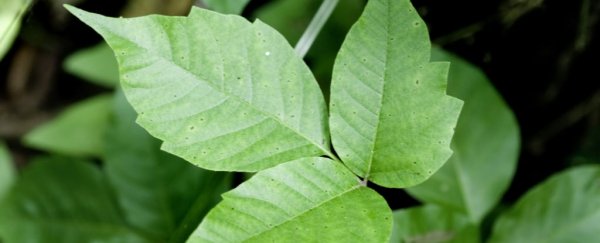An international team of researchers has finally decoded the science behind a plant responsible for no small degree of human misery: poison ivy.
For the first time, we now know why poison ivy leaves – the bane of campers, hikers, and overly curious kids alike – make us itch, and the answer lies in a key molecule called CD1a, which scientists have long known about but didn't fully understand until now.
"For over 35 years we have known CD1a is abundant in the skin," says researcher Jerome Le Nours from Monash University in Australia. "Its role in inflammatory skin disorders has been difficult to investigate and until now has been really unclear."
One of the reasons for that lack of clarity has been that many experiments on skin disorders involve animal testing – specifically lab mice. And mice don't produce CD1a, effectively creating a kind of 'blind spot' in the studies up to this point.
To get around this and examine whether CD1a might play a part in how human skin reacts when we brush up against poison ivy (Toxicodendron radicans) and similar rash-inducing plants, the researchers genetically engineered mice that did produce the molecule.
In doing so, the team found that CD1a – a protein that plays an important role in our immune systems – triggers a skin-based allergic reaction when we come into contact with urushiol, the allergen that functions as the active ingredient in plants like poison ivy, poison oak, and poison sumac.
When urushiol interacts with skin cells called Langerhans cells, the CD1a proteins (which are expressed by Langerhans cells) activate the immune system's T cells. In turn, the T cells produce two proteins – interleukin 17 and interleukin 22 – which cause inflammation and itchiness.
While we've long known that urushiol was what provoked itching and inflammation, the rest of the chain reaction has eluded scientists for decades, because mice don't have CD1a.
The researchers stumbled on the possible connection when one of the team, microbiologist Florian Winau from Harvard University, was studying urushiol's chemical structure. Winau noticed that the molecular shape of the allergen might be suitable for binding with CD1a, which ultimately led to testing the hypothesis in the lab.
"Whenever we talk about the project, we get a really nice response," says Winau, who is lucky to have never had a brush with poison ivy. "People have a … very close connection to this [and say], 'I had it bad and it's horrible!'"
And while it may have taken us a long time to identify the molecular ingredient that makes all that pain possible, the silver lining is that now that we know about CD1a's starring role in urushiol-based itching, we might be able to do something to block it.
While there's never any guarantee that the results of animal testing will be replicated in future experiments with humans, the researchers think we're definitely on the right track with this molecule.
"We now have a target to further investigate," says Le Nours. "Our basic discovery may make a big difference in the future treatment and prevention of inflammatory skin diseases."
And the benefits won't just be felt by campers who happen to pick the wrong path when two diverge in a yellow wood. The researchers think CD1a could play a key role in all kinds of skin reactions, meaning this could lead to even bigger discoveries.
"Future research could lead to the development of new treatments to combat minor skin irritations as well as chronic inflammatory skin diseases like psoriasis, eczema, and rosacea," says Tang Yongqing from Monash University.
In the meantime, if you have the misfortune of running into poison ivy, here's what to do to minimise the reaction.
The findings are reported in Nature Immunology.
